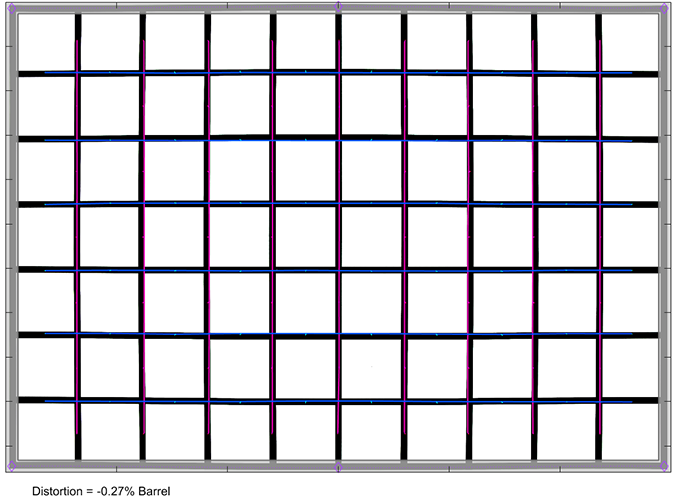|
Tokina atx-m 23mm f/1.4 E - Review / Test Report - Analysis |
|
Lens Reviews -
Sony Alpha/NEX (APS-C)
|
|
Page 2 of 3

Distortion
The Tokina atx-m 23mm f/1.4 E doesn't really require image auto-correction when it comes to image distortions. It produces a tiny barrel distortion of 0.27%. There's a mustage-style sub frequency in there but given the low base distortion, it's not really annoying.

Vignetting
The vignetting characteristic of the Tokina lens is roughly in line with other high-speed lenses. At f/1.4, there's a quite heavy light falloff of ~1.6EV (f-stops). Stopping down to f/2 helps but if you want to get rid of most of it, you may wish to stop down to f/4.
Note: We are using straight JPGs for the vignetting test. Due to the different tonal graduation, this results in different vignetting results between manufacturers for the same lens design.

MTF (resolution)
The Tokina atx-m 23mm f/1.4 E has two souls when it comes to resolution. The broader center performance is very good at f/1.4 and even better at f/2 but the borders and corners are weak. The lens jumpstarts at f/2.8, where the outer image field improves drastically. The peak performance is reached between f/4 and f/5.6 with very good quality for the borders/corners. Diffraction has a higher impact beyond but f/8 remains very usable whereas f/11 (not shown) sees a more pronounced decrease in resolution.
The field curvature is marginal. The centering quality of the tested sample was good.
Please note that the MTF results are not directly comparable across the different systems!
Below is a simplified summary of the formal findings. The chart shows line widths
per picture height (LW/PH) can be taken as a measure for sharpness.
If you want to know more about the MTF50 figures you may check out the corresponding
Imatest Explanations

Chromatic Aberrations (CAs)
Lateral CAs are fairly high at a large aperture with a peak of ~1.7px on average at the image borders. However, the CAs improve substantially from f/2.8 onward and rarely represent an issue.

Bokeh
If you are interested in such a lens, you do so because of the ultra-large aperture and its shallow depth-of-field potential - and the quality of the bokeh (rendering of the out-of-focus blur) becomes an important criterion.
The Tokina lens isn't perfect, but it has its merits. The rendering of out-of-focus highlights is very good. The lens does not feature aspherical elements which is the type of special glass that tends to introduce artifacts. Thus highlights are very clean as you can see below. While the lens has nine aperture blades, a slightly edgy aperture shape does show up at f/2 already, though.
 The images below illustrate the deterioration of the out-of-focus highlights towards the image corners. Note: Please ignore the fuzzy shape of some discs - this is a side effect of the wide-angle character of the lens in conjunction with the protruding photodiodes of the test scene.
The highlight discs are intact in the broader center zone but deteriorate towards the borders/corners of the image field - this is a mechanical vignetting effect that is pretty much unavoidable. The circular shape can be restored by stopping down but a complete correction requires a quite small aperture setting.
As far as the general blur is concerned, the results are mixed again. The fore- and background blur is quite smooth near the image center but things are getting rougher in the corners - which is to be expected, though.
The images below illustrate the deterioration of the out-of-focus highlights towards the image corners. Note: Please ignore the fuzzy shape of some discs - this is a side effect of the wide-angle character of the lens in conjunction with the protruding photodiodes of the test scene.
The highlight discs are intact in the broader center zone but deteriorate towards the borders/corners of the image field - this is a mechanical vignetting effect that is pretty much unavoidable. The circular shape can be restored by stopping down but a complete correction requires a quite small aperture setting.
As far as the general blur is concerned, the results are mixed again. The fore- and background blur is quite smooth near the image center but things are getting rougher in the corners - which is to be expected, though.

Bokeh Fringing (LoCA)
Bokeh fringing - also called LoCAs - is a color fringing effect on the Z-axis. It shows purplish halos in front of the in-focus zone and greenish beyond. The effect is clearly visible at f/1.4. Stopping down to f/2 reduces the fringing and there are traces left at f/2.8. As usual, the LoCAs are mostly gone from f/4 onward (not shown).
Keep in mind that bokeh fringing is normal in all but a handful of very expensive APO lenses.
|